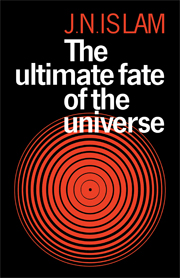Book contents
- Frontmatter
- Contents
- Preface
- Dedication
- Note on some conventions
- 1 Introduction
- 2 Our Galaxy
- 3 The large-scale structure of the universe
- 4 Elementary particles – a preliminary look
- 5 Is the universe open or closed?
- 6 Three ways for a star to die
- 7 Black holes and quasars
- 8 Galactic and supergalactic black holes
- 9 A black hole is not forever
- 10 Slow and subtle changes
- 11 Future of life and civilization
- 12 A collapsing universe
- 13 The steady state theory
- 14 The stability of the proton
- 15 Epilogue
- Glossary
- Selected bibliography
- Index
10 - Slow and subtle changes
Published online by Cambridge University Press: 06 July 2010
- Frontmatter
- Contents
- Preface
- Dedication
- Note on some conventions
- 1 Introduction
- 2 Our Galaxy
- 3 The large-scale structure of the universe
- 4 Elementary particles – a preliminary look
- 5 Is the universe open or closed?
- 6 Three ways for a star to die
- 7 Black holes and quasars
- 8 Galactic and supergalactic black holes
- 9 A black hole is not forever
- 10 Slow and subtle changes
- 11 Future of life and civilization
- 12 A collapsing universe
- 13 The steady state theory
- 14 The stability of the proton
- 15 Epilogue
- Glossary
- Selected bibliography
- Index
Summary
In quantum mechanics it turns out that phenomena which are forbidden in classical physics (such as particles escaping from a black hole) have a small, but real chance of happening by a mechanism called tunneling, whereby a particle crosses a ‘classical’ barrier. By a classical barrier we mean one that would be a barrier if only the laws of classical physics operated. Thus an electron which does not have sufficient energy to surmount the barrier produced by an electrical field bounces off the barrier and cannot penetrate it according to the laws of classical physics, as shown in the upper sketch in Fig. 10.1. The wavelike properties of matter in quantum mechanics, however, give the electron a small chance of getting through (see lower sketch in Fig. 10.1). This phenomenon of tunneling is important in radioactive decay of a heavy nucleus such as a uranium or a radium nucleus and also in some processes in electronics. Since quantum effects are essentially microscopic effects, it is difficult to give an example of the phenomenon of tunneling in terms of every day happenings, but presently we shall try to explain radioactivity in such terms.
We shall see that the phenomenon of quantum tunneling causes some slow and subtle changes in the remaining pieces of matter after all the black holes have gone, or even before the black holes disappear. These processes would not be possible according to classical physics, since the latter implies that the matter in the form of white dwarfs, neutron stars and other smaller pieces of matter would stay in the same form forever.
- Type
- Chapter
- Information
- The Ultimate Fate of the Universe , pp. 96 - 104Publisher: Cambridge University PressPrint publication year: 1983



